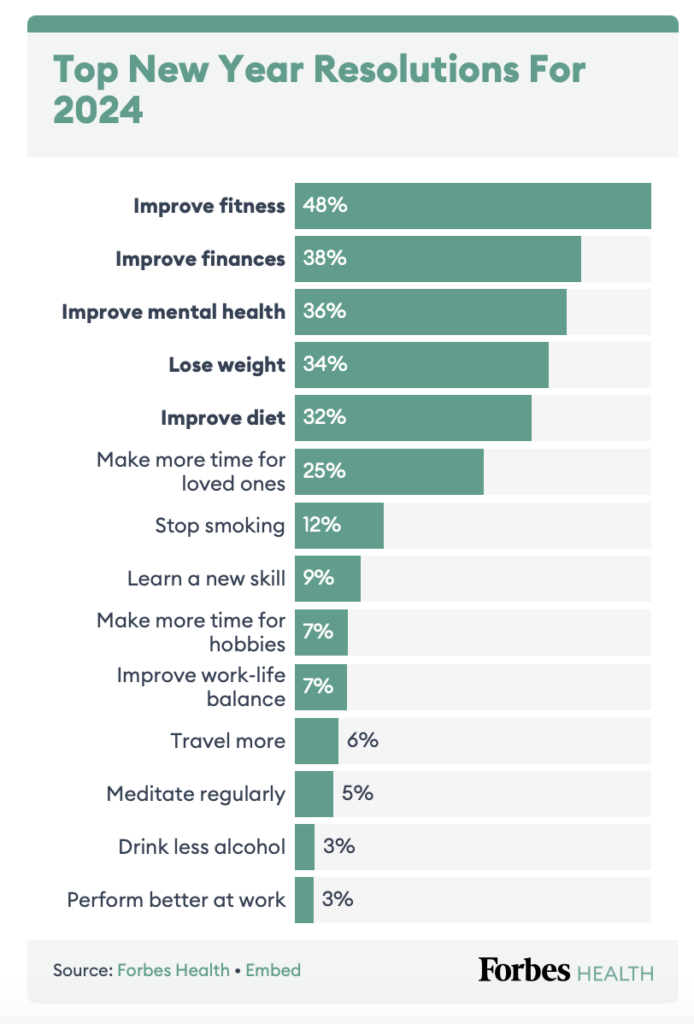The New Year Resolutions Phenomenon
The tradition of making New Year’s resolutions dates back over 4,000 years to ancient Babylon. The Babylonians, in a celebration called Akitu, marked the beginning of the new year with promises to their gods to pay debts and return borrowed items, believing it would lead to favor in the coming year. Similarly, the Romans made resolutions to the god Janus, the namesake of January, seeking his blessings for the year ahead.
Over time, the concept of New Year’s resolutions has evolved, transcending religious and cultural boundaries. They signify a collective desire for positive change and a fresh start as individuals reflect on the past and aspire to be better in the future. Notably, the act of setting resolutions often involves a sense of communal solidarity, as many people worldwide engage in this shared tradition, fostering a global spirit of optimism and renewal as one year transitions into the next.
2024 At A Glance
According to a recent survey published in Forbes Health, the top resolutions for 2024 centered around health, appearance and self-improvement. They include improved fitness, improved finances, improved mental health, weight loss and improved diet. Approximately 59% of young adults (age 18-34) set New Year’s resolutions, making them the largest demographic to engage in this phenomenon.

Despite the widespread popularity on New Year resolutions, research suggests only 9% of Americans actually complete them. Researchers also estimate 23% of people quit by the end of the first week, and 43% quit by the end of January.
While the temporal milestones drive motivation and newfound sense of hope, it can also result in high rates of relapse. A number of obstacles can contribute to failure to achieve resolutions.
Obstacles you create on your own:
- Fear of failure
- Fear of what others might think
- Lack of self-efficacy (belief you do not have the abilities and skills to accomplish the goal)
- Procrastination
- Self-doubt
Obstacles created in your surrounding environment:
- Your daily routine, especially deadlines and tasks that take priority over your goal
- Your office or home environment
- People that give bad advice or do not believe in you
Breaking Down the Barriers
Achieving your resolutions becomes a more tangible reality when you delve into the fascinating intersection of science and personal transformation. Scientific research reveals that our brains possess remarkable neuroplasticity, allowing them to adapt and form new habits. By understanding the psychological processes at play, you gain insights into how to reshape your thinking patterns and behavior.
“Starting with really easy steps is how we start to build momentum and maintain the motivation to remain consistent. This prioritizes high-intensity focus on what we can achieve in the moment, and prevents us from giving into the mental drift and distraction promoted by our subconscious patterns.”
James Clear, Atomic Habits: An Easy and Proven Way to Build Good Habits and Break Bad Ones
Research shows that approach-oriented goals are significantly more successful than avoidance-oriented goals. Approach-oriented goals involve reaching or maintaining a desired outcome, like becoming fitter and stronger or eating a healthier diet. Avoidance-oriented goals, on the other hand, involve eliminating an undesired outcome, like losing weight or giving up sweets. The difference is where the brain prioritizes focus. Avoidance goals are preceded by fear of failure and the brain is consumed with instant gratification, or what it wants in this immediate moment. However, approach goals stem from the need for achievement and are more likely to direct the brain to prioritize delayed gratification. In other words, it’s easier to make the needed changes now because we’re more connected with a future version of ourselves that enjoys this accomplishment.
In line with this thinking, new research encourages people to pursue goals more for reasons of pleasure and altruism and less for necessity or fear of losing their self-esteem. The researchers note, “Positive emotions are associated with creativity, optimism and resourcefulness. They create an “upward spiral” toward greater happiness and well-being.” Altruism is the practice of concern for the happiness or well-being of others and animals, above oneself. Altruistic activities are among the most meaningful activities, which also correlate to greater well-being.
A comprehensive review of over 100 research studies revealed the best strategy for exerting self-control is “situation change.” Rather than exposing ourselves to temptations and hoping we possess the willpower to resist, it’s better to avoid confronting them in the first place. How long do we have to avoid temptation? Researchers have long tried to pinpoint a time frame for new habit formation. In fact, there are whole teams of scientists and labs devoted to answering the single question, how can we form new habits? But unfortunately, there’s no clear, cut answer. One researcher asserts, “Habits typically develop asymptotically and idiosyncratically, potentially differing in rate across people, cues and behaviors.”
Your Ultimate Guide to Achieving New Year Resolutions
- Set a specific, realistic approach-oriented goal
- Focus on what you want to gain and achieve, rather than what you would be giving up
- Be specific so that you are able to track progress and set achievable milestones. You cannot manage something unless you are able to measure it.
- Create a detailed plan for X amount of weeks
- Set up mechanisms for accountability
- Having a support system can significantly impact your ability to adhere to new routines
- Tell a friend, join a support network or hire a coach to maintain momentum
- Track your progress
- Use a journal or app to measure your progress and achievement milestones over time.
- Rebound quickly after set-back
- Breaking old habits and establishing new ones is a gradual process that requires persistence. Don’t underestimate the time it takes to replace ingrained behaviors
- Setbacks are a natural part of the change process and opportunities for extreme growth and introspection
- Visualize your success
- For just 10 minutes a day, prioritize focus on achievement. What have you gained 1 year from now as a result of this achievement? How do you feel about yourself?
- Bring to mind the “why” behind your resolution and what it means to you. Slow progress may be discouraging but you will gradually see more and more results over time.
- Enjoy the process and support others as often as you can
- The ultimate goal is to be at peace with yourself, not add another layer of stress and fear and poor self-esteem. Create a space for yourself that’s safe to grow and fail and redirect so that you can generate loving energy for yourself and others.
- Mentally reframe the purpose and significance of your goals to remind you of how meaningful they are. Consider the positive impact on people in your life, your community and the environment.
James Clear, Atomic Habits: An Easy and Proven Way to Build Good Hab“So, what if instead of thinking about solving your whole life, you just think about adding additional good things. One at a time. Just let your pile of good things grow.”
Rainbow Rowell





